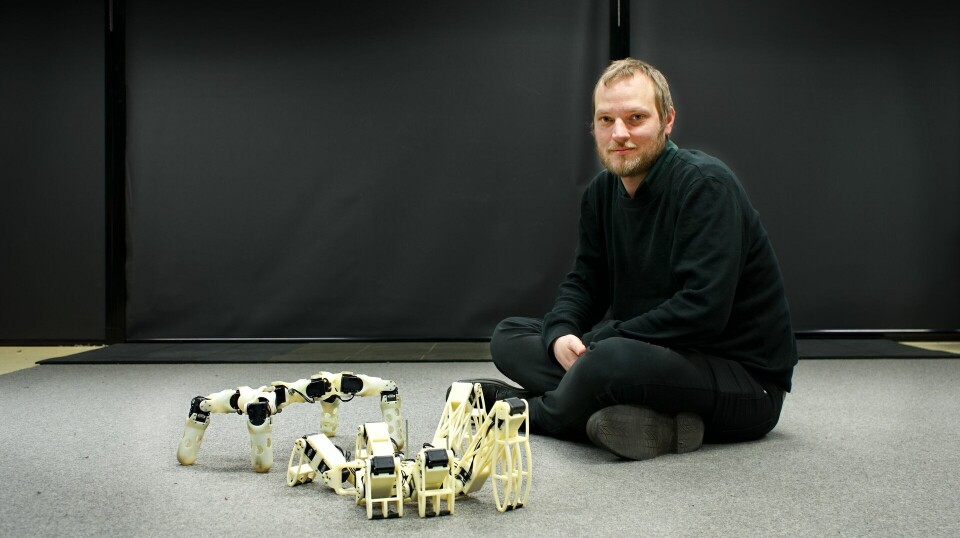THIS ARTICLE/PRESS RELEASE IS PAID FOR AND PRESENTED BY University of Oslo - read more

Can robots find the rhythm and be moved by music?
Music can be used to get people to move to the beat. Researchers want to know if we can apply the same trick to robots.
Have you ever tried standing completely still when your favourite song comes on?
It’s difficult not to move your body when a catchy tune is played.
Standing still to a good beat is actually so difficult that it has triggered an avalanche of research projects. One of them looks at whether music can also be used to get robots to move to a beat.
“A big focus of our research is the involuntary and irresistible urge to move to a good beat,” postdoctoral fellow Alexander Szorkovszky says.
Szorkovszky works at RITMO Centre for Interdisciplinary Studies in Rhythm, Time and Motion at the University of Oslo. He wants to find out whether it is possible to coordinate robots using the rhythms that can be found in music.
Robots losing control to music
“The most common approach in robotics is to give robots maximum control and stability in their movements. But what happens if you give up this control to music, for example?” Szorkovszky ponders.
According to Szorkovszky, movement to music can be viewed in two different ways: One is that music literally sets you off – you are passively reacting to the rhythm. The other is that you predict the rhythm and deliberately move in time with the beat.
“I am exploring the idea that music sets you off,” he says.
A digital robot
The robot Szorkovszky created is currently digital. The screen shows a simple robot with four legs. In the software, the robot is a passive recipient of the rhythm and is controlled by the music – that is if it is able to pick out the beat.
“In order for people to want to move, the rhythm should have the right complexity. It gets boring if the rhythm is too simple. If it is too complex, it becomes difficult to identify the beat,” he says. “This robot does not currently have the ability to experience boredom, so it works well with simple rhythms.”
Szorkovszky takes inspiration from neural circuits known as central pattern generators. Researchers believe that these circuits contribute to several biological rhythms, such as the rhythms of breathing or walking.
Movements are rooted in the spine
For humans, the circuit for walking is literally found in the spine. Models of central pattern generators can also be used to control the movements of legged robots. This is why robots may be useful for investigating whether these circuits can spontaneously synchronise to external stimuli, such as the rhythm of music.
To develop the central pattern generators, Szorkovszky explains, they are using evolutionary optimisation on a large group of virtual robots.
Using evolution in the context of robots means that the robots with the best characteristics are selected from each generation to move on to the next. Minor mutations or changes may appear in each generation.
The algorithm also combines parent robots in order to create new combinations of characteristics. In this way, the evolutionary algorithm generates a variety of movement styles.
When the robots test their dance skills, Szorkovszky selects the best robots from the evolution software. That is, the robots that are most able to synchronise to the tempo.
Szorkovszky starts the simulation and the music begins. The robot is moving on all four legs. After a short while, the robot starts to follow the beat. As time passes, the music becomes more complex and it becomes harder for the robot to follow the beat. Eventually the robot struggles to ‘shuffle’ its legs around.
In the Hall of the Mountain King was too hard – how about a waltz?
Szorkovszky has tested various types of music.
“I tried In the Hall of the Mountain King, but it started off too slow,” Szorkovszky says.
The simulation currently includes just one four-legged robot. Eventually, Szorkovszky would like to find out what happens if the robot is given more legs.
“I want to try and find out what happens if a six-legged robot is tasked with dancing to a waltz. Would it end up moving straight forwards, or around in circles?” he says.
Humans naturally start to twirl around when we hear a waltz as we move on two legs, but this is not a given if the number of legs is different. He has yet to test this theory.
So far, Szorkovszky has proven that it is possible to control a robot using simple beats. In time, he intends to test whether robots can coordinate their movements with music and with one another. They also intend to test the experiment using physical prototypes.
Here, a virtual four-legged robot spontaneously moves to a rhythm. (Video: bosonicyouth / YouTube)
Reference:
Szorkovszky et al. 'Central pattern generators evolved for real-time adaption', ArXiv, 2022. DOI: 10.48550/arXiv.2210.08102 Abstract.

This article/press release is paid for and presented by the University of Oslo
This content is created by the University of Oslo's communication staff, who use this platform to communicate science and share results from research with the public. The University of Oslo is one of more than 80 owners of ScienceNorway.no. Read more here.
See more content from the University of Oslo:
-
Putin’s dream of the perfect family
-
How international standards are transforming the world
-
A researcher has listened to 480 versions of Hitler's favourite music. This is what he found
-
Researcher: "AI weakens our judgement"
-
New, worrying trend among incels, according to researcher
-
Ship’s logs have shaped our understanding of the sea




































